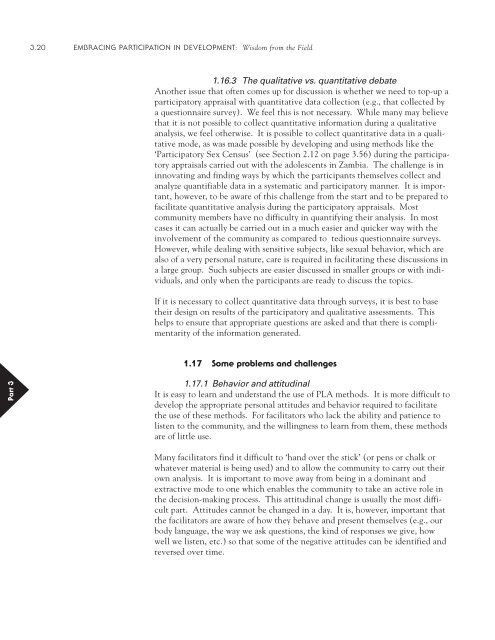PRA-Manual Embracing Participitation tools-only.pdf - PACA
PRA-Manual Embracing Participitation tools-only.pdf - PACA
PRA-Manual Embracing Participitation tools-only.pdf - PACA
Create successful ePaper yourself
Turn your PDF publications into a flip-book with our unique Google optimized e-Paper software.
3.20 EMBRACING PARTICIPATION IN DEVELOPMENT: Wisdom from the Field<br />
1.16.3 The qualitative vs. quantitative debate<br />
Another issue that often comes up for discussion is whether we need to top-up a<br />
participatory appraisal with quantitative data collection (e.g., that collected by<br />
a questionnaire survey). We feel this is not necessary. While many may believe<br />
that it is not possible to collect quantitative information during a qualitative<br />
analysis, we feel otherwise. It is possible to collect quantitative data in a qualitative<br />
mode, as was made possible by developing and using methods like the<br />
‘Participatory Sex Census’ (see Section 2.12 on page 3.56) during the participatory<br />
appraisals carried out with the adolescents in Zambia. The challenge is in<br />
innovating and finding ways by which the participants themselves collect and<br />
analyze quantifiable data in a systematic and participatory manner. It is important,<br />
however, to be aware of this challenge from the start and to be prepared to<br />
facilitate quantitative analysis during the participatory appraisals. Most<br />
community members have no difficulty in quantifying their analysis. In most<br />
cases it can actually be carried out in a much easier and quicker way with the<br />
involvement of the community as compared to tedious questionnaire surveys.<br />
However, while dealing with sensitive subjects, like sexual behavior, which are<br />
also of a very personal nature, care is required in facilitating these discussions in<br />
a large group. Such subjects are easier discussed in smaller groups or with individuals,<br />
and <strong>only</strong> when the participants are ready to discuss the topics.<br />
If it is necessary to collect quantitative data through surveys, it is best to base<br />
their design on results of the participatory and qualitative assessments. This<br />
helps to ensure that appropriate questions are asked and that there is complimentarity<br />
of the information generated.<br />
1.17 Some problems and challenges<br />
Part 3<br />
1.17.1 Behavior and attitudinal<br />
It is easy to learn and understand the use of PLA methods. It is more difficult to<br />
develop the appropriate personal attitudes and behavior required to facilitate<br />
the use of these methods. For facilitators who lack the ability and patience to<br />
listen to the community, and the willingness to learn from them, these methods<br />
are of little use.<br />
Many facilitators find it difficult to ‘hand over the stick’ (or pens or chalk or<br />
whatever material is being used) and to allow the community to carry out their<br />
own analysis. It is important to move away from being in a dominant and<br />
extractive mode to one which enables the community to take an active role in<br />
the decision-making process. This attitudinal change is usually the most difficult<br />
part. Attitudes cannot be changed in a day. It is, however, important that<br />
the facilitators are aware of how they behave and present themselves (e.g., our<br />
body language, the way we ask questions, the kind of responses we give, how<br />
well we listen, etc.) so that some of the negative attitudes can be identified and<br />
reversed over time.














